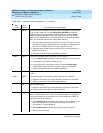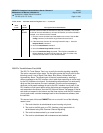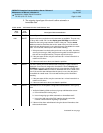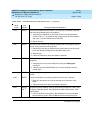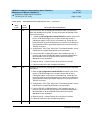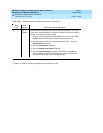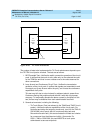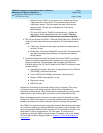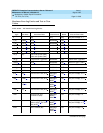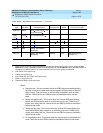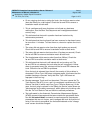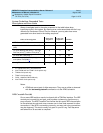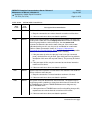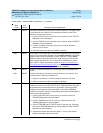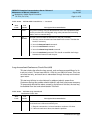
DEFINITY Enterprise Communications Server Release 6
Maintenance for R6vs/si
555-230-127
Issue 1
August 1997
Maintenance Object Repair Procedures
Page 10-1368TIE-TRK (Tie Trunk)
10
— Seizure Test (for TN497 circuit packs only)—Verifies the seizure
capabilities of the circuit pack. This test seizes the trunk and
outpulses a "pause." The port reports the result of the seizure
attempt uplink. The test can be disabled via Trunk Group
Administration.
— Tie Trunk Dial Test (for TN439 circuit packs only)—Verifies the
seizure and dialing capabilities of the circuit pack. This test
ABORTS on trunk ports administered as access endpoints.
4. EPF, M, and E Lead Test [G3iV1.1-286 and G3iV2-386 only]—ABORTS on
trunk ports administered as access endpoints. This test consists of two
parts:
■ E lead test—Checks for the proper activation and deactivation of
the port’s E lead.
■ M lead test—Checks the M lead EPF current flow. The results of this
test allow for distinguishing between circuit pack and external
facility failures.
5. Port Audit Update Test (Audit & Update Test for the TN497 circuit pack)—
Sends non-disruptive administrative updates to the circuit pack with no
expected response. The test updates the translation information on
individual ports of the Tie Trunk. Except for the TN497 circuit pack, these
updates include:
■ Immediate, automatic, wink start, or delay dial and for the TN2140
[G3iV2-386], continuous-seize-ack
■ For the TN2140 [G3iV2-386], continuous or discontinuous.
■ Rotary or DTMF senderization in or out
■ Disconnect timing
■ DMTF time slot
Additional in-line testing is performed while a call is in progress. Thus, many
in-line errors may occur during operation. See the Error Log table for a
description of these errors. These errors may be reproduced by using the trunk
(making a call), and checking their occurrence in the Hardware Error Log.
Before a maintenance test can be run on a port, the port is required to be idle.
Except for a TN497 circuit pack, if an incoming call seizes the port which is being
tested by maintenance, the test is aborted, and the incoming call proceeds.
Non-TN497 circuit packs can be configured for back-to-back testing (also known
as connectivity testing) by making translation and cross-connect changes. This
testing configuration allows for the connection of Tie Trunks back-to-back in the
same switch to verify the operation of Tie Trunk ports. The tests can be
performed in either the E&M or simplex modes. For details, refer to the "Analog
Tie Trunk Back-to-Back Testing" section in Chapter 5, ‘‘
Routine Maintenance
Procedures’’



